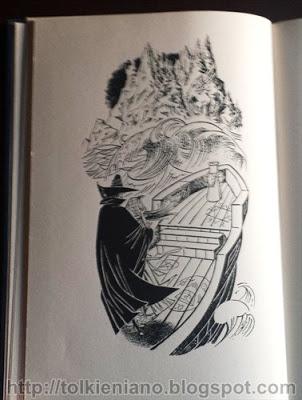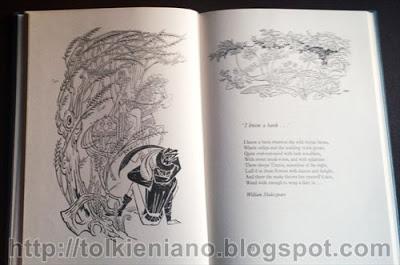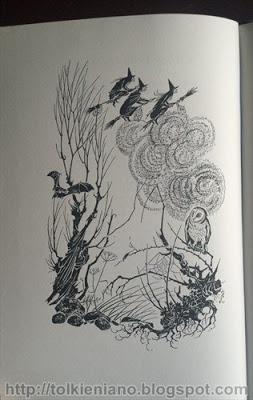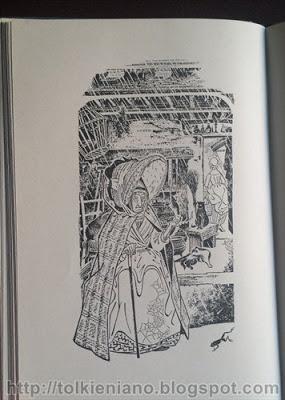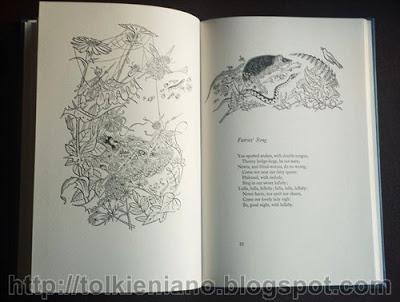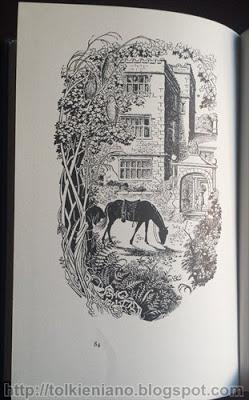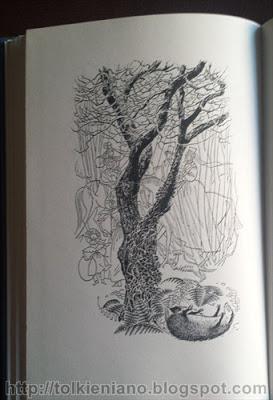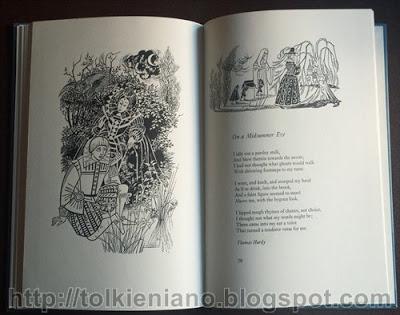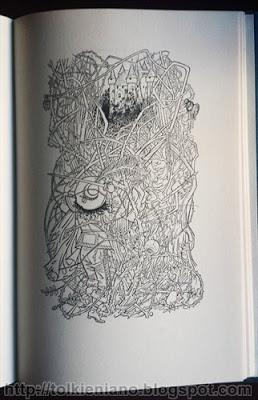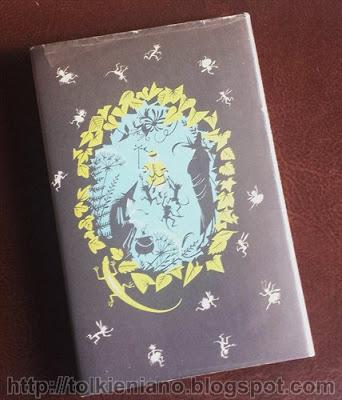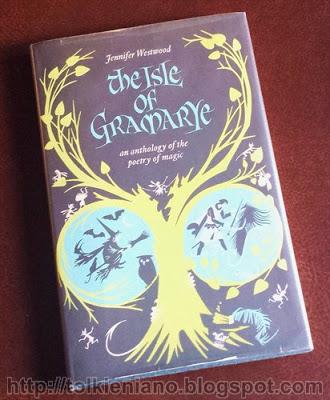
The Isle of Gramarye: an anthology of the poetry of magicA cura di Jennifer WestwoodHart-Davis, 1a ed. 1970, pp. 93Illustrazioni di copertina a colori di Pauline BaynesIllustrazioni interne b/n di Pauline BaynesRilegato con sovraccoperta
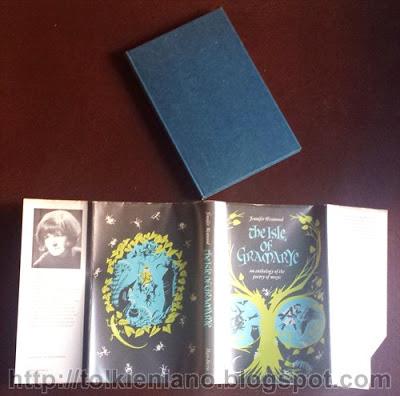
Info
The Isle of Gramarye è la Gran Bretagna di Merlino, una terra di strani incontri e improvvisi incantesimi. In questo libro sono raccolte poesie, vecchie e nuove, di questa regione di ombre e dei suoi abitanti - stregoni, incantatrici ei morti viventi. L'antologia è destinata soprattutto ai bambini da 9 a 12, con un gusto per la magia e la poesia.
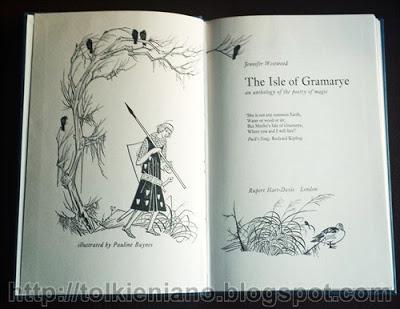
La raccolta comprende diverse canzoni tradizionali e poesie sul tema scritte di William Shakespeare, John Keats, Edwin Muir, Walter de la Mare, W.B. Yeats, A.E. Housman, Edith Sitwell, Robert Graves, Lord Alfred Tennyson, Thomas Hardy, Rudyard Kipling, John Masefield, Charles Causley, Wilfred Owen e due del Professor J.R.R. Tolkien.
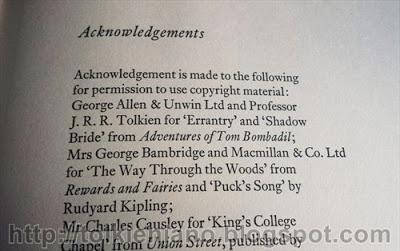
Il libro e Tolkien
La Westwood nei riconoscimenti, ringrazia l’editore George Allen and Unwin e il Professor J.R.R. Tolkien per Errantry e Shadow Bride. Il libro, infatti, contiene le due poesie tratte da The adventures of Tom Bombadil pubblicato per la prima volta nel 1962.
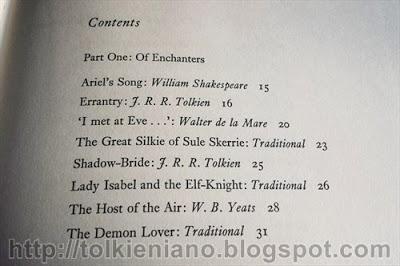
Errantry, tradotta in italiano con Il cavaliere errante, nella prefazione Tolkien la presenta come una poesia molto amata dagli Hobbit, la cui fine riprende l'inizio, con tratti molto simili a quella che Bilbo recita a Rivendell. Questo componimento è possibile attribuirlo a Bilbo che lo avrebbe composto subito dopo il ritorno dal suo viaggio. Narra di un marinaio e messaggero, che attraversa i fiumi per compiere la sua missione dopo aver caricato di provviste la gondola appena costruita. Durante il viaggio incontra una farfalla e, dopo averla catturata, le costruisce un palazzo di gigli omaggiandola con sete e gioielli che però li sparpaglia, e così il marinaio la lascia per riprendere il suo viaggio saccheggiando e guerreggiando tra gli arcipelaghi dopo averci litigato. Il marinaio si costruisce un'armatura d'avorio corallo e smeraldi e, dopo esser riuscito a sconfiggere le libellule, i calabroni e gli elfi, e impadronitosi del loro favo dorato, costruisce una barca di foglie e broccoli e fa ritorna a casa dove si ricorda di non aver ancora compiuto la sua missione: così la poesia può ricominciare.
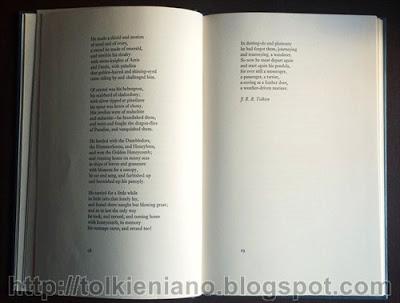
Shadow Bride, tradotta in italiano La sposa dell'ombra, secondo Tolkien, sempre nella prefazione, è una poesia che origine dai marginalia del Libro Rosso. Narra la storia di un uomo che viveva solo, stando sempre immobile seduto su una pietra senza produrre ombra. L’incantesimo si ruppe quando vicino a lui si fermò una fanciulla che, da allora, vive nelle profondità dalle quali esce una sola volta all'anno per danzare insieme all'uomo.
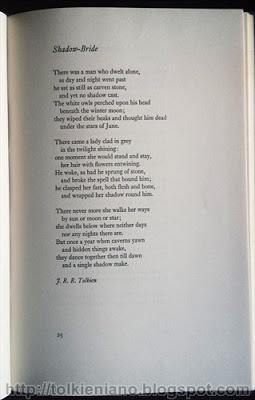
Introduzione al testoThe title of this anthology was taken from Puck's Song in Rudyard Kipling's Puck of Pook'ls Hill, because in that book Puck, the last of the fairies, shows two Sussex children, Dan and Una, an England they had never seen before, an England which was at once the realm of Queen Victoria and Merlin's Isle of Gramarye. Gramarye is an old form of the word grammarwhich once meant "learning in general", then came to mean "occult learning or magic", perhaps because in olden days, when very few people could read, it seemed to those who could not that all books were books of magic and all readers witches and magicians. So gramarye as Kipling uses it means "magic, enchantment", and his enchanted isle was one where Puck himself, and many strange people out of the past, told the children of old adventures and ancient spells. We, too, are going to explore an Isle of Gramarye, though this time it not quite the same thing as England, for some of the poems are set in the Western Isles of Scotland, in Ireland, or in regions mysterious and unspecified. But it is a place where enchantments and enchanters, fairy and human, can be encountered at every turn, where the barriers between past and present are not clear, so that ghosts may walk. In Thomas Rhymer, there are three roads, one to Heaven, one to Hell, and one to Fairyland. This implies that fairies were thought of as neither good nor bad, but something betwixt and between. Being in the middle, they can easily step to one side or the other, and so we or find Shakespeare portraying them as helpful to mankind, while the ballad-writers often show them as downright malignant. In this anthology I have tried to show you as many different attitudes to the fairy-world as possible. Also betwixt and between in English poetry are the waking dead, or ghosts. These are seldom represented as malignant; they are, rather, forlorn misfits deserving of pity not fear, although the poems about them may still be eerie and frightening. The anthology does not pretend to include all the poets who write about the supernatural, and you will find some poets represented by more than one poem. This is simply because I like their treatment of the subject and think that you will like it too. If you should want more reading, try Goblin Market by Christina Rosseti, The Forsaken Merman by Matthew Arnold, Santorin by James Elroy Flecker, and The Pied Piper of Hamelin by Robert Browning, all of which were too long for inclusion here. Younger readers may find some of the poems hard, older ones may think some of them babyish. I apologize here and now, but this book is not meant for readers of any one age. I have made it in the hope that it will contain something for everyone~-everyone, that is. who likes things "magicky" and strange.
Jennifer Westwood

La curatrice
Quando Jennifer Westwood ha curato questo volume aveva 29 anni, viveva con il marito, il figlio e il cane Hodge a Victorian Islington. Ha studiato presso il Sir John Leman School, alla St Anne's College di Oxford, e al New Hall di Cambridge. Nel 1970 stava completando il suo dottorato di ricerca.sull’Old Icelandic. Nel 1967, sempre per Rupert Hart-Davies, pubblicò la raccolta in prosa Medieval Tales, che il Times Literary Supplement lo definì “un eccellente selezione di racconti - tra cui l'incomparabile Aucassin e Nicolette”, anche quello illustrato da Pauline Baynes. Ha scritto anche Albion: A Guide to Legendary Britain (1985), Gothick Cornwall (1992), Lost Atlantis (1997) e On Pilgrimage(2003). È membro della Henry Doubleday Research Association, della British Hedgehog Preservation Society e della Society of Authors. Oggi vive a Norfolk.
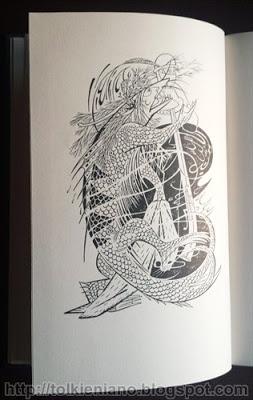
Le illustrazioni di Pauline Baynes
Il volume presenta circa diciassette illustrazioni realizzate da Pauline Baynes, l’illustratrice preferita di C.S. Lewis, di cui ha illustrato i libri de Le Cronache di Narnia e J.R.R. Tolkien. Di quest’ultimo ha illustrato Farmer Giles di Ham (1949), The Adventures of Tom Bombadil (1962), Smith of Wootton Major (1967); le copertine dell’edizione di The Hobbit (1961), di The Lord of the Rings (1968) e la poesia Bilbo Last Song (1974). I disegni della Baynes ricordano molto quelli realizzati per Tolkien, meravigliosi ed evocativi.
